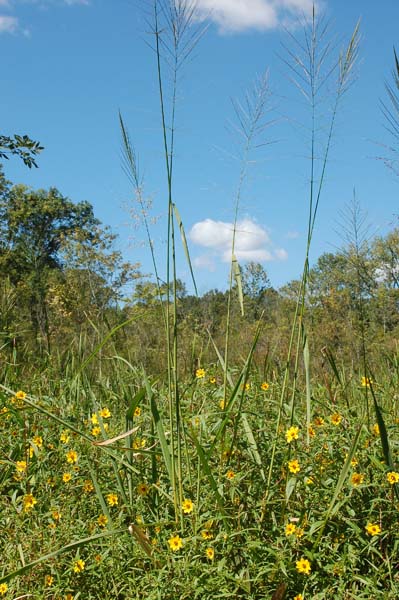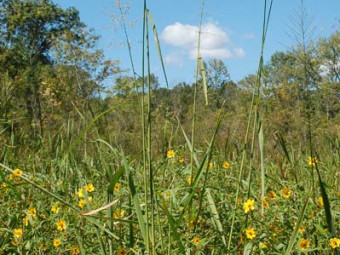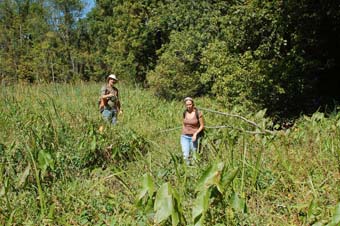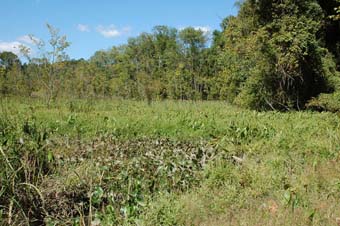Freshwater Tidal Mixed High Marsh
System: Palustrine
Subsystem: Herbaceous
PA Ecological Group(s): Tidal Wetland and River Floodplain
Global Rank:GNR
![]() rank interpretation
rank interpretation
State Rank: S1

General Description
Intertidal high marsh occupies areas of low-lying, nearly level land adjacent to the upper edge of the sloping river bank. These areas are not flooded at every high tide but rather at times of the highest tides (new moon, full moon, or storms). However, high marsh often includes small tidal channels in which the water level varies with the tide. Unlike riverbank tidal marsh, high marsh is not distinctly zoned, except occasionally along the engraved channels. The vegetation is typically dense and is dominated by a large variety of robust herbaceous wetland species.
Species include tidal marsh specialists such as wild-rice (Zizania aquatica), swamp beggar’s-ticks (Bidens bidentoides), showy bur-marigold (Bidens laevis), and salt-marsh water-hemp (Amaranthus cannabinus). Numerous more widespread wetland plants may also be present such as sweet-flag (Acorus calamus), common cat-tail (Typha latifolia), arrow-arum (Peltandra virginica), pickerel-weed (Pontederia cordata), wapato (Sagittaria latifolia), water-pepper (Persicaria punctata), halberd-leaf tearthumb (Persicaria arifolia), marsh-purslane (Ludwigia palustris), rice cutgrass (Leersia oryzoides), jewelweed (Impatiens capensis), sensitive fern (Onoclea sensibilis), rose-mallow (Hibiscus moscheutos), and climbing hempweed (Mikania scandens). Other species that may be present include false nettle (Boehmeria cylindrica), purple-stemmed aster (Symphyotrichum puniceum), wingstem (Verbescina alternifolia), beggar-ticks(Bidens frondosa), mad-dog skullcap (Scutellaria lateriflora), common dodder (Cuscuta gronovii) and the dodder (Cuscuta campestris) may also be present growing on a variety of herbaceous hosts.
Invasive, non-native species that may be present include common reed (Phragmites australis), grass (Arthraxon hispidus), purple loosestrife (Lythrum salicaria), and yellow flag (Iris pseudacorus).
Rank Justification
Critically imperiled in the jurisdiction because of extreme rarity or because of some factor(s), such as very steep declines, making it especially vulnerable to extirpation .
Identification
- The lack of zonation distinguishes this tidal marsh type
- Dominated by wild-rice (Zizania aquatica), salt-marsh water-hemp (Amaranthus cannabinus), and swamp beggar-ticks (Bidens bidentoides)
- Occurs on Coastal Plain
Herbs
- Wild-rice (Zizania aquatica)
- Swamp beggar-ticks (Bidens bidentoides)
- Showy bur-marigold (Bidens laevis)
- Salt-marsh water-hemp (Amaranthus cannabinus)
- Rose-mallow (Hibiscus moscheutos)
- Common cat-tail (Typha latifolia)
- Sweet flag (Acorus calamus)
- Arrow-arum (Peltandra virginica)
- Pickerel-weed (Pontederia cordata)
- Wapato (Sagittaria latifolia)
- Tussock sedge (Carex stricta)
- Dotted smartweed (Persicaria punctata)
- Tearthumb (Persicaria sagittata)
- Rice cutgrass (Leersia oryzoides)
- Clearweed (Pilea pumila)
- Marsh-purslane (Ludwigia palustris)
* limited to sites with higher soil calcium
Vascular plant nomenclature follows Rhoads and Block (2007). Bryophyte nomenclature follows Crum and Anderson (1981).
International Vegetation Classification Associations:
USNVC Crosswalk:None
Representative Community Types:
Freshwater Tidal Mixed High Marsh (CEGL006325)
NatureServe Ecological Systems:
Northern Atlantic Coastal Plain Fresh and Oligohaline Tidal Marsh (CES203.516)
NatureServe Group Level:
None
Origin of Concept
Rhoads and Block
Pennsylvania Community Code*
na : Not Available
*(DCNR 1999, Stone 2006)
Similar Ecological Communities
Freshwater Tidal Mixed High Marsh overlaps with the upper zone of Riverbank Freshwater Tidal Marsh, the two types have a number of species in common. The main difference between them is the elevation above mean high tide and the lack, in the high marsh, of a distinct slope and the resulting zonation of the vegetation. Freshwater Tidal Mixed High Marsh may also resemble Mixed Forb – Graminoid Wet Meadow community. However, the presence of tidal marsh species such as wild-rice (Zizania aquatica), salt-marsh water-hemp (Amaranthus cannabinus), and swamp beggar’s-ticks (Bidens bidentoides) is definitive.
Fike Crosswalk
None. This type is new to the Pennsylvania Plant Community Classification developed from inventory studies of Bucks County by Morris Arboretum.
Conservation Value
Freshwater Tidal Mixed High Marsh is a rare community type in Pennsylvania and provides habitat for species not found elsewhere in Pennsylvania. This community also serves as a buffer for sediment and pollution runoff from adjacent developed lands by slowing the flow of surficial water causing sediment to settle within this wetland, providing a flood buffer along the Delaware Estuary. Rare species may include wild-rice (Zizania aquatica), showy bur-marigold (Bidens laevis), salt-marsh water-hemp (Amaranthus cannabinus), swamp beggar’s-ticks (Bidens bidentoides), river bulrush (Schoenoplectus fluviatilis), Walter’s barnyard grass (Echinochloa walteri), and gypsy-wort (Lycopus rubellus).
Threats
Threats to intertidal high marsh communities include sea level rise; conversion to residential, commercial, or industrial uses, water pollution, and colonization by non-native invasive species, especially common reed (Phragmites australis ssp. australis). Inappropriate land use, such as planned waterfront housing developments, continues to threaten the remaining unprotected tidal marsh occurrences.
Management
There is a need to identify sites where existing land use could allow for inland migration of freshwater tidal marsh communities as sea level rises and secure theses sites as protected open space. All remaining freshwater tidal marsh communities should be protected from incompatible land use. Opportunities for restoration of freshwater tidal marsh communities should also be pursued. Invasive species control should be implemented at sites where common reed (Phragmites australis ssp. australis) is established.
Research Needs
All remaining freshwater tidal marsh sites should be inventoried, evaluated, and mapped. In addition, quantitative inventory data are needed to refine descriptions of species composition. Regular monitoring should be instituted at selected sites.
Range Map

Pennsylvania Range
Tidal high marsh is very limited in Pennsylvania, the best remaining examples are found in Bucks County along the Neshaminy Creek at Neshaminy State Park and at Biles Island.
Global Distribution
Northeastern North America coastal region from Quebec to Virginia (NatureServe 2011)
Pennsylvania Department of Conservation and Natural Resources (DCNR). 1999. Inventory Manual of Procedure. For the Fourth State Forest Management Plan. Pennsylvania Bureau of Forestry, Division of Forest Advisory Service. Harrisburg, PA. 51 ppg.
Stone, B., D. Gustafson, and B. Jones. 2006 (revised). Manual of Procedure for State Game Land Cover Typing. Commonwealth of Pennsylvania Game Commission, Bureau of Wildlife Habitat Management, Forest Inventory and Analysis Section, Forestry Division. Harrisburg, PA. 79 ppg.
Cite as:
Rhoads and Block 2022. Pennsylvania Natural Heritage Program. Freshwater Tidal Mixed High Marsh Factsheet. Morris Arboretum. Available from: https://naturalheritage.state.pa.us/Community.aspx?=30007 Date Accessed: March 28, 2025











